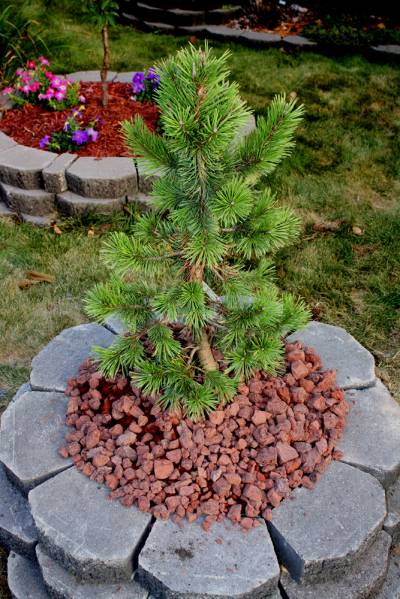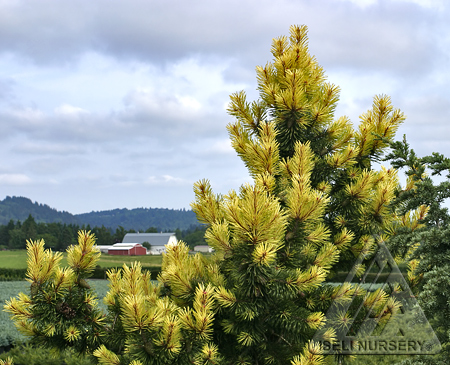
Use Compost, Save Money
August 22nd, 2010Behold! My new Pinus Contorta “Taylor’s Sunburst”!

I know it doesn’t look anything special now, but this is one rare and amazing plant. In the spring the new growth lights up to a bright yellow (in contrast with the dark green older growth) in an amazing display. In Spring it will look like this:

So, did I name this post incorrectly? What does this tree have to do with compost and saving money? Well as I said, this is one rare and amazing plant. At Gee Farms, where I bought mine, a new grafted one about 6 inches tall is $50. A 4 foot one is $900. Mine, listed at 2 foot (but really two and a half+, I was told it has been potted up for sale at that size for 2 seasons), was $200.
Pretty expensive. If 4 feet is $900 then each half foot is over $100, and each inch is just under $20, lets round up and call it $20 an inch.
I make my own compost with my compost tumbler, but despite the fact that I compost just about everything I can. All garden waste, tree trimmings, all kitchen scraps that aren’t meat, etc. Despite all that, I garden so much I can’t make enough compost to fulfill all my garden needs. So I always ending buying more.
At the garden center 40 pound bags of topsoil are about $1 each, 40 pound bags of composted manure are $1.50 each. The compost however is a far far better growing medium. When you plant something you have just that one opportunity to improve the soil, you need to take it.
I’ve heard in some places when you plant a tree you should mix some native soil into the planting hole because you don’t want the tree to get “confused” or “disappointed.” I don’t buy it, for one, trees don’t think, they don’t have feelings, and in nature, all the time, will tree roots go through different types of soil. Secondly, I’ve noticed no problems planting trees in super improved soil, in fact, I’ve noticed only benefits. I think this whole theory was a result of one guy’s poor intuition that unfortunately caught on.
So anyways, you should always plant your new plants in the best soil possible, and full compost is the best soil possible. Yes, it is more expensive than top soil, but it is not expensive, it is still cheap, just not as cheap. Suppose a tree planted in composted manure grows just 1 inch per year more than a tree planted in top soil. With my new tree that 1 inch is worth $20 a year. I only needed to buy 4 bags of compost for this tree, so that is only $2 in extra cost, for $20 the first year, and that is if the compost only gives me 1 extra inch, if it gives a larger benefit the benefit is even higher.
Of course my tree is really expensive, not all trees are, but mine is also slow growing, and not all trees are. If you had a fast growing tree like a lombardy poplar you might get an extra foot or two per year by planting in really good soil.
An ounce of prevention equals a pound of cure, and a bag of compost up front can give you pounds of wood down the road. Spend the couple extra quarters up front and get bagged compost for all your planting (I also plant veggies directly in it), your plants will do better, and the increased yields and growth will far far outweigh the incremental cost of the compost.

August 27th, 2010 at 6:34 am
I can never make enough compost either! In fact one of my neighbors has offered her non-meat kitchen waste to me and I may end up taking her up on that. Meantime, like you, I buy composted manure when I need more.
August 31st, 2010 at 4:49 pm
I love your analysis of the per-inch cost of the tree!
I think the reason people mix native soil in is because there can be beneficial fungi that can help most types of plants. If you take the soil from around the roots of a plant of a similar species you’ll have the best results (and you should apply near the roots of the new plant).
I personally compost meat too, since I also use a compost tumbler.
September 1st, 2010 at 10:57 am
“you have just that one opportunity to improve the soil, you need to take it.” how true is that!
Your new tree is awesome, and I love how you built the little retainer around it. So cool.
I’ve been learning a lot this year about soil fertility, amending problem soil, new farming methods, and it all points back to this exact thing, organic material, and I too started composting.
My neighbors dump their grass clippings in the empty lot next door, so I did the builder a solid and cleaned up! for the missing brown material and to cover the ammonia smell, I added straw (1 bale goes a LONG way), shredded newspaper, sawdust. And threw in some rabbit food, the alfalfa meal is supposed to break it down faster.
Once I moved it into direct sun, started turning daily, scrambling it with the tiller, and keeping it evenly moist, it breaks down in just a few weeks!
So I built a huge bin, 5’x14′, for the neighbors to dump their grass clippings and leaves in. I haven’t put food in yet, since we have lots of critters out here. Saving that for the sealed worm bin!
A big bin may not be the ideal solution for everyone, and probably a LOT more work than a nice and tidy tumbler, but I now have about 3 yards of finished compost and more on its way.
Love your posts by the way, I have you in my igoogle reader!
October 12th, 2010 at 5:59 pm
That is one cool conifer. I would worry a little about the raised bed and the retaining blocks. The tree needs room to spread its roots!
October 17th, 2010 at 5:28 am
It is a slow grower Alana, it’ll be fine in that 4 foot diameter ring for… 20 years. Plus, the ring is open on the bottom, and so the roots can escape that way.
April 23rd, 2011 at 9:04 am
great post…
Are you buying the compost from the garden center in big plastic bags, or getting them from a yard by the pound? The compost I’ve seen here in Tucson is about $3-5 for a 2 cubic foot bag!
August 2nd, 2011 at 9:00 am
I remember when I discovered the wonders of compost! Before that I was just planting and praying. I’m into vermicomposting now, and I’m having a lot of success with my Worm Factory.